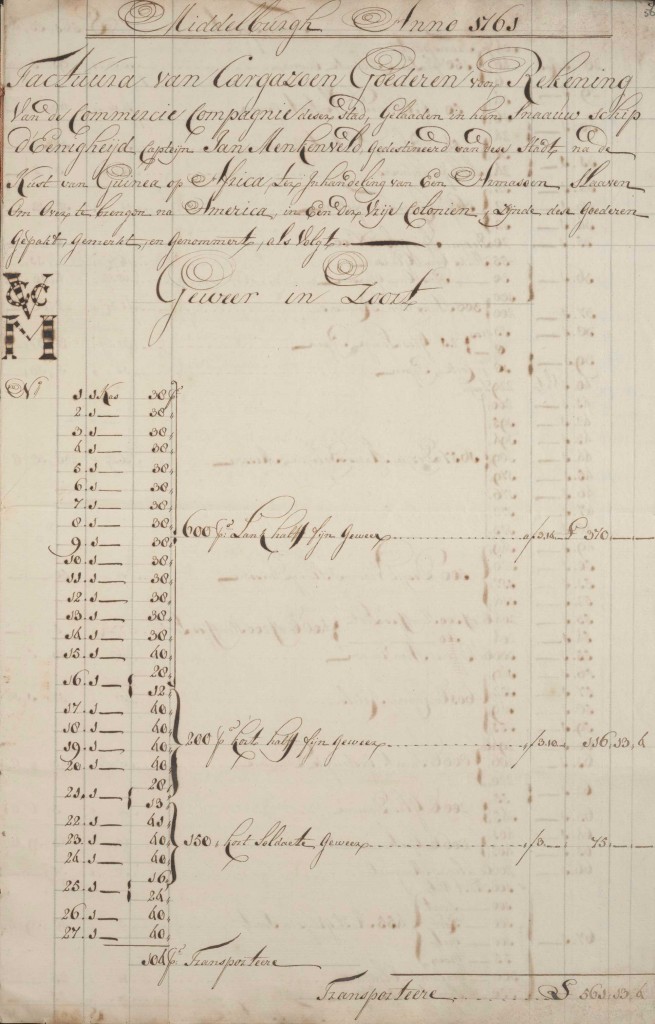The cargo of trading goods which were loaded on board in Zeeland chiefly consisted of goods for West-Africa. Named ‘cargoson’, these goods were to be specifically used in Africa to trade for enslaved Africans, ivory and gold. In addition to this, The Unity also carried some privately commissioned goods destined for the Caribbean.
Cargo for Africa
The cargo destined for Africa was put together with care, accommodated to demand. This demand differed per location – not just regarding different types of goods, but also their quality. The cargo included an array of textiles for example, all of differing quality. The captain was expected to be aware of the local demand, and was ordered by the board to put together the first concept cargo.
List of Cargo Goods
The ‘account of cargo goods’ is a list of all goods, including the quantities and prices. The list also shows how the goods were packed and shipped.
Most of the cargo was packed in 89 numbered chests, barrels and one pack. The cargo, ordered by number, consisted of:
- Guns: 600 long, half fijne copper [read: bronze] guns, 200 short, half fijne guns, 150 soldier’s guns, 150 long soldier’s guns, 50 ‘gebruneert vertint’ guns, 50 ‘blank vertint’ guns, 24 ship’s swords – packed together in 31 chests numbered 1 to 31.
- Trumpets and mirrors: 36 copper trumpets, 20 dozen mirrors – packed together in 4 chests numbered 32 tol 35.
- Glass items: 55 beer glasses, 30 beer glasses, 300 wine glasses – packed together in 2 chests, numbered 36 and 37.
- Tobacco pipes: 21 gros long pipes, 18 gros short, or slave pipes – packed together in 2 chests, numbered 38 and 39.
- Knifes: 1657 dozen ‘man baline’ knives, 500 dozen ‘woman snake’ knives – packed together in 13 barrels numbered 40 to 52.
- Lead: 200 bars of lead, weighing 408 pounds – packed in 2 barrels numbered 53 and 54. ‘200 blocks of 2 pounds, to be poured in square blocks.’
- Copper: 300 pounds of copper arm rings, 601 pounds of copper kettles – packed in 5 barrels numbered 55 to 59.
- Beads: 800 pounds of black, striped ‘dominé’, 200 pounds of glass ‘dominé’, 806 pounds of yellow ‘dominé’, 200 pounds of small ‘margriet’, 455 mast of white, black, red, yellow and green ‘gruis’, 300 mast of flamed ‘olivetten’, 150 mast of black with white dots – packed in 8 barrels numbered 60 to 67.
- Padlocks: 16 dozen three-sided padlocks – packed in one barrel numbered 68.
- Tin bowls: 100 tin bowls – packed in one barrel numbered 69.
- Textiles and snuff boxes: packed in 17 barrels and 1 pack number 70 to 87. Next to textiles, barrel 79 also contained 8 dozen snuff boxes: ‘varnished, pale snuff boxes’.
- Tobacco: 800 pounds of leaf tobacco – packed in 2 barrels numbered 88 and 89.
Loose goods:
- Bars of Swedish iron: 100 bars with a total weight of 2128 pounds
- Copper basins: 602 pounds
- Small copper bars: 50 pounds
- Stone jugs from Cologne: 300 large jugs and 300 small jugs
- Grease (cattle grease): 30 large and small barrels with grease ‘approved inland’, with a total weight of 405 kilos.
The list concludes with the liquors and gunpowder:
- Brandy: 3 half butts, 200 anchors of 12 steckans, 100 half anchors of 6 steckans, 50 ‘kelders’ (chests) of 6 bottles, 240 chests of 6 jugs.
- Rossolis (liqueur): 110 chests of 6 jugs
- Gunpowder: 300 small barrels of 36 pounds, 250 small barrels of 18 pounds and 100 small barrels of 6 pounds.
Weights and Measures in Middelburg
Many different local and regional weights and measures were in use in the Republic. Those mentioned above probably used Middelburg’s own system:
- The Middelburg pound: 467.7 grams (Amsterdam pound: 494.096 grams)
- Middelburg steckan: 2.25 liters
- Middelburg quart: 1.12 liters
Other measures used in the ship’s inventory:
- Butt (large water barrel): 563 liters (with the VOC)
- Anchor: 35 to 39 liters
- Bottle: one anchor of 35 liters consisted of 45 bottles.
The Captain and First Mate: Merchants
The role of the captain was essential in putting together the cargo. Apart from his responsibilities of the ship, cargo and crew, the captain was also responsible for the all of the conducted trade. The cargo list was put together by him, on orders of the board.
Together with his first mate, the captain inspected the entire cargo on board in the last few days before departure. Both then signed the cargo list, which was added to the ship’s documents.
Throughout the voyage the captain and the first mate together kept track of the conducted trade. Which goods had left the ship? Which goods and enslaved Africans were brought on board? And where on the ship were the goods stored? The reason for this arrangement was that should the captain pass away, the first mate would be capable of answering for the trade-accounts in detail. If the first mate failed to do so, he would forfeit his salaries.
Value and Insurance
The cargo was insured for 6 % of its total value (the purchase price of the goods), which amounted to 37,129.90 guilders, which, when converted to current values, 252 years later, is equivalent to 374,903.41 euros (506,331.51 dollars). Source: International Institute of Social History





